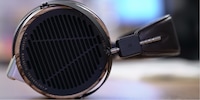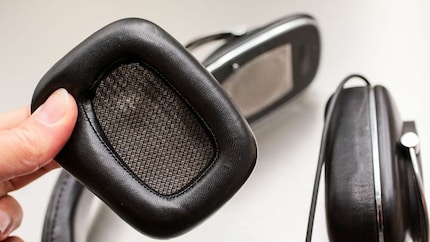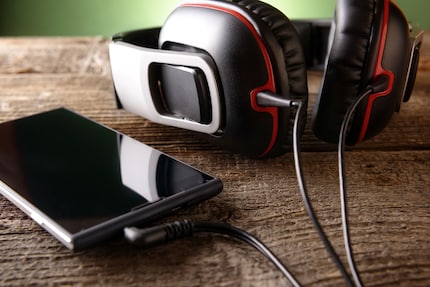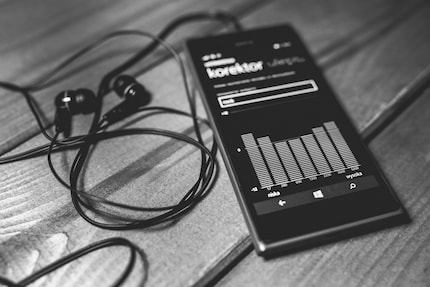
Product test
What's a CHF 2,200 helmet really worth?
by Aurel Stevens

Why do mobile headphones with 32 Ohm impedance play significantly louder on a smartphone than large hi-fi headphones with 300 Ohm transducers? Are they inherently louder? Not in principle - the reason for this can be found elsewhere.
Everyone who has ever tried to connect large hi-fi headphones to their smartphone knows the effect: it sounds great, but even with the volume control turned all the way up, the volume is inadequate - with the included button headphones, on the other hand, it almost blows up your ears in this position.
It is not entirely correct to deduce from this that hi-fi headphones are generally quieter due to their higher impedance. To make a fair comparison, you first need to determine how much of the electrical energy supplied by the device the headphones convert into sound. This is exactly what the so-called sensitivity describes: it indicates the sound pressure level (given in decibels dB) that a pair of headphones produces when supplied with an electrical power of 1 milliwatt (mW) (the test frequency is usually 500 hertz).
This reads like this, for example: Sensitivity headphone model B&W P7 Wireless = 95 dB/mW. The smaller model B&W P5 Wireless, on the other hand, has a sensitivity = 92 dB/mW. In comparison, the P7 Wireless has a 3 dB higher characteristic sound pressure level than the P5 Wireless - which means that it has a better efficiency: The P7 converts the electrical power supplied by 3 decibels and thus twice as well into acoustic power (double efficiency) as the P5.

By definition, efficiency always expresses the ratio of power output to power input. The efficiency of headphones is therefore determined exclusively by the efficiency of the sound transducers - and this is primarily characterised by the strength of the magnets used and the magnetic flux density in the air gap in which the voice coil moves during diaphragm drive.
The efficiency and thus the sensitivity of a headphone is therefore completely independent of its impedance. However, the question remains: Why do 32-ohm headphones usually play significantly louder on a smartphone than hi-fi headphones with 300 ohm impedance? The crux of the matter is that the sensitivity is a power-related specification - because the reference value is 1 milliwatt.
At this point, we can't help but use the calculator to do a little calculation. Let's assume we have two headphones (A and B) with the same sensitivity (i.e. identical efficiency) of 102 dB/mW - but different impedance: 300 ohms for headphone A, 32 ohms for headphone B.

And this is where the crucial question comes into play: What electrical voltage is required in each case to supply 1 milliwatt of power to both sets of headphones so that they produce identical sound pressure levels of 102 decibels?
Here we go:
Given: the power P (1 milliwatt = 0.001 watts)
and the impedances (headphones A = 300 ohms; headphones B = 32 ohms)
Wanted: the electrical voltage U (in volts, V) for headphones A and B
According to Ohm's law:
P = U2/R
from this follows: √(P x R) = U
Headphones A:
√(0.001W x 300 Ohm) = 0.548 V
Headphones B
√(0.001W x 32 Ohm) = 0.179 V
We can see that the 300 ohm headphones A require a signal voltage more than 3 times as high as headphones B in order to draw 1 milliwatt of power from the amplifier (i.e. the smartphone). Conversely, this also means that 32-ohm headphones B only require a third of the voltage for 1 milliwatt of power consumption (and therefore the same volume as headphones A).
This makes the case clear: at the same volume setting, the 32-ohm headphones B play almost exactly twice as loud (approx. 10 dB) as the 300-ohm headphones A.

Let's summarise: A technically correct volume comparison between different headphones is only possible if the electrical power supplied is the same (keyword: characteristic sound pressure level). In practice, however, 32-ohm mobile headphones always play significantly louder than their 300-ohm hi-fi counterparts, as their low impedance at a given output voltage means they sneak out more power - and that's the real trick. In order to compensate for this effect and thus play as loud as headphones B at a given volume setting, the 300-ohm headphones A from our example would have to have a 10 decibel higher characteristic sound pressure level.
To summarise: Hi-fi headphones with their usually high capsule impedance require significantly higher output voltages from the amplifier than low-impedance mobile headphones to achieve sufficient volume. High-impedance headphones are therefore rather unsuitable for use with smartphones & Co, as the latter usually cannot provide the required output voltage.
My audio career began as a live sound engineer for renowned artists such as Franz Josef Degenhardt, Hannes Wader, Lydie Auvray and Abdullah Ibrahim. It was at the studio mixing desk that I found my real "home" - as a musician in front of it and as a sound engineer behind it. Today, I enjoy the privilege of being able to live both: the sound engineer in mastering sound carriers and technical depth, the musician in creative romp. At Lowbeats I am responsible for the areas of professional fidelity, digital and recording technology.
Interesting facts about products, behind-the-scenes looks at manufacturers and deep-dives on interesting people.
Show all